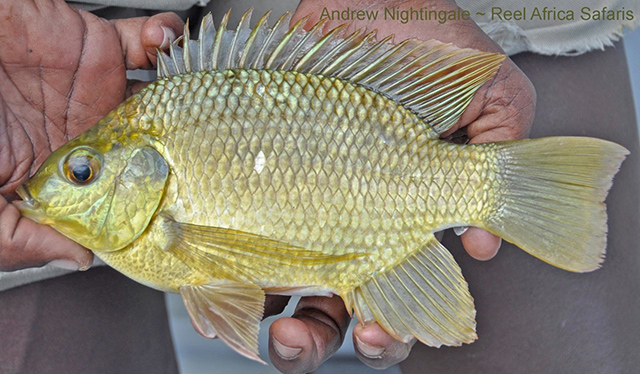| Cichlidae (Cichlids), subfamily: Pseudocrenilabrinae |
| 39.5 cm TL (male/unsexed); max.weight: 1,618.0 g |
|
demersal; freshwater; brackish; depth range - 5 m, potamodromous |
| Africa and Eurasia: Jordan system, especially in lakes; coastal rivers of Israel; Nile system, including the delta lakes and Lake Albert and Turkana; in West Africa in the Senegal, Gambia, Casamance, Géba, Konkouré, Sassandra, Bandama, Comoé, Niger, Volta, Tano, Lake Bosumtwi, Mono, Ouémé, Ogun, Cross, Benue, Logone, Shari and Lake Chad; Draa (Morocco), Adrar (Mauritania); Saharian oases Borku, Ennedi and Tibesti in northern Chad; Sanaga and Nyong basins in Cameroon (Ref. 4999). In the Congo basin, Sarotherodon galilaeus boulengeri is known from the lower and middle Congo River from Matadi to Pool Malebo (=Stanley Pool) and the lower Kasai (Ref. 2) and Lukenie (Ref. 55074) while Sarotherodon galilaeus galilaeus is present in the middle Congo River basin, in the middle Congo River and drainages of the Ubangi, Uele (Ref. 2, 55074), Itimbiri (Ref. 2, 55074, 106290), Aruwimi (Ref. 106290) and Lomami (Ref. 106245). Sarotherodon galilaeus is also reported from the Luilaka River (Ruki drainage, middle Congo River basin) (Ref. 93897). Five subspecies are recognized: Sarotherodon galilaeus borkuanus, Sarotherodon galilaeus boulengeri, Sarotherodon galilaeus galilaeus, Sarotherodon galilaeus multifasciatus, Sarotherodon galilaeus sanagaensis. |
|
Dorsal spines (total): 15-17; Dorsal soft rays (total): 12-13; Anal spines: 3-3; Anal soft rays: 9-11; Vertebrae: 28-30. Diagnosis: 21-25 rakers on lower limb of first arch; length of lower pharyngeal jaw < 43.5% of head length; 29-32 scales in lateral line series; head length 32.5-39% of standard length; toothed area of lower pharyngeal jaw broad > 2-3 times in keel length (Ref. 81260).
Description: head length 32.5-35.5% SL; lower pharyngeal jaw with unicuspid anterior teeth and straight posterior teeth; ventral keel elongate, longer than dentigerous plate; 1-4 rows of teeth in oral jaws, outer row teeth bicuspid (Ref. 81260).
Coloration: bluish grey, blue-purple dorsally, grey-white ventrally; 4-6 faint, narrow, vertical bars on flank and caudal peduncle; bars on flank thin and often extending well below level of mid-body; upper lip same color as upper part of snout, lower lip pale or whitish, same color as throat and chest; dorsal fin bluish grey, 2 rows of round clear maculae in interspinous membrane, maculae becoming more numerous in soft dorsal; "tilapia spot" only faintly evident, or absent; caudal fin dark bluish grey with clear maculae medially; anal fin dark bluish grey, more clear in upper part where there are sometimes clear maculae (Ref. 81260). |
| Has been known to occur at 9°C; occasionally form schools; territorial (Ref. 2). Adults prefer open waters but juveniles and breeding adults are found inshore (Ref. 4999). Often associated with beds of submerged vegetation in Sudd lakes; feed on algae and fine organic debris; bi-parental mouthbrooder (Ref. 28714). Lacks marked sexual dichromatism when sexually active; forms temporary pair bonds (Ref. 81260). Maximum size recorded at 41.0 cm TL (Ref. 2756). |
|
Least Concern (LC); Date assessed: 23 April 2020 Ref. (130435)
|
| harmless |
|
Jordan valley. |
Source and more info: www.fishbase.org. For personal, classroom, and other internal use only. Not for publication.

